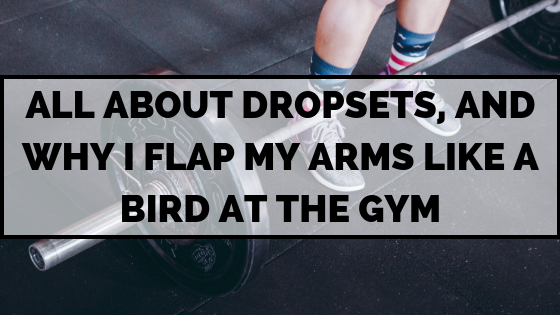All About Dropsets, And Why I Flap My Arms Like A Bird At The Gym
Takeaway Points:
Dropsets are a popular technique in which you perform one or several traditional sets and then drop weight and quickly perform one or several additional sets to failure or near failure. These sets are popular because they generate a significant pump and enable us to train close to failure without too much additional effort or time.
The research on dropsets is mixed - it seems likely that this additional effort needs to be balanced with recovery in order to see proper long term results, the same as any lifting technique.
However, this makes them very useful for a) people who don’t have much time to train, and want to minimize their time in the gym, and b) when training for smaller muscle groups and isolation exercises, which naturally recover more quickly anyway.
One technique I like is to combine dropsets with unweighted exercise - and as a result, flapping my arms at the gym.
Here’s a dirty secret of mine. I enjoy looking like a fool at the gym by flapping my arms like a bird. Here’s an example:
Why do I do this?
As I’ve explored previously, unweighted exercise can be a useful tool in any lifter’s toolkit. While we used to believe that it was only possible to build muscle and strength via the use of external load, we have evidence that this is not necessary, at least with beginners and in situations where even a small amount of an exercise stimulus will do the trick.
This doesn’t mean that unweighted exercise is recommended as a long term strategy. As I explored in that post, I’ve often used it with clients as a way to bridge the gap between disability and basic function, and from there, weighted exercises can slowly be added in.
But there’s another long-term use for this kind of unweighted exercise: as a kind of dropset after already exhausting a muscle, particularly during weaker isolation exercises.
In dropsets, you’re finishing up with your main work sets, and then you’re quickly adding in additional sets with minimal rest, dropping weight (typically about 20-25%) so that you can quickly complete reps without issue.
Dropsets have been significantly studied recently, in part because they’re a popular technique to get in more training volume and exhaust the muscles. The argument for dropsets is that you can get in a great deal of additional work, very quickly, while working close to metabolic failure. The argument against dropsets is that, like many kinds of complete failure training, has the potential to cause burnout and lead to a longer term decrease in your results.
However, the positive results seen in some research suggest that it’s definitely a technique worth trying out, so long as you can manage it carefully and don’t go overboard. Those training fewer times per week (and who have less time to train) may benefit from dropsets more because they don’t have to worry as much about recovery, anyway. If you’re someone who doesn’t have much time to train during the week, it’s perfect as a way to maximize results while minimizing time spent in the gym. (For other methods to save time in the gym, check out this post.)
So for example, if I’m doing a bench press (a very naturally strong movement) and want to do a dropset, I can just remove some of the weight from the bar and do a lighter set to near failure. In this case, unweighted movement may not be an effective dropset simply because it’s too light, unless the muscles are excessively fatigued (which isn’t a good thing for your long term results).
But when it comes to isolation exercises, which are naturally weaker, you can’t handle much weight to begin with. Bicep curls, tricep extensions, lateral raises, calf raises, and similar variations will all develop slowly, and you can’t handle much weight on these exercises before form breaks down. In addition, they’re a great candidate for more fatiguing exercise techniques like dropsets, because smaller muscle groups recover quickly to begin with.
If you wanted to do a dropset with these exercises, sometimes it’s fine to simply remove some weight. But another option is just to go entirely weightless, and mimic the movements with unweighted, no-load exercise.
And thus - flapping my arms like a bird. It’s a much more effective shoulder finisher after a tough set of overhead presses or lateral raises than you might think. Give it a try.
About Adam Fisher
Adam is an experienced fitness coach and blogger who's been blogging for 5+ years, coaching for 6+ years, and lifting for 12+ years. He's written for numerous major health publications, including Personal Trainer Development Center, T-Nation, Bodybuilding.com, Fitocracy, and Juggernaut Training Systems.
During that time he has coached hundreds of individuals of all levels of fitness, including competitive powerlifters and older exercisers regaining the strength to walk up a flight of stairs. His own training revolves around powerlifting and bodybuilding.
Adam writes about fitness, health, science, philosophy, personal finance, self-improvement, productivity, the good life, and everything else that interests him. When he's not writing or lifting, he's usually hanging out with his cat or feeding his video game addiction.
Follow Adam on Facebook or Twitter, or subscribe to our mailing list, if you liked this post and want to say hello!
Enjoy this post? Share the gains!
Further Reading:
Ready to be your best self? Check out the Better book series, or download the sample chapters by signing up for our mailing list. Signing up for the mailing list also gets you two free exercise programs: GAINS, a well-rounded program for beginners, and Deadlift Every Day, an elite program for maximizing your strength with high frequency deadlifting.
Interested in coaching to maximize your results? Inquire here.
Some of the links in this post may be affiliate links. For more info, check out my affiliate disclosure.


